How to propagate blackberries in spring, summer and autumn: methods (by layering, offspring, cuttings)
Perhaps the majority of summer residents will agree that it is better to have not one blackberry bush on your own plot, but several, because there are never many delicious blackberry berries. There are a lot of ways to reproduce blackberries. You just need to figure out when it is best to do it and which method is right for your strain.
Well, then let's talk in more detail about how to properly propagate blackberries in spring, summer and autumn.
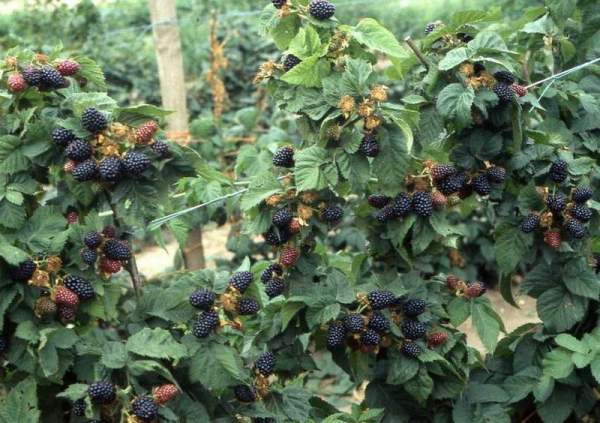
Content
When to propagate blackberries in spring, summer and fall
Blackberries are propagated at any time of the year - in spring, summer and autumn, except for winter. For each period, different methods of shrub propagation are suitable:
- Spring - perfect timing for transplanting already rooted cuttings (root and stem) and young blackberry seedlings to a permanent place. Also at this time root suckers and cuttings are planted, multiply dividing the bush.
- In summer blackberries are propagated replacement shoots tops (apical layers), horizontal layers, more precisely, during this period they are buried in the ground, cut and rooted green cuttings.
With the summer reproduction of blackberries by dividing the bush, there is a danger that the bush will not be able to successfully take root because of the heat - high air temperature. Therefore, if you decide to divide the bushes in the summer, although it is better to do this in spring or autumn, then be sure to mulch them and water them regularly.
- Autumn (August-October) usually harvest root suckers and cuttings for their further planting in the spring. Also cut lignified stem cuttings. Just like in summer drop the tops of the replacement shoots (apical layers) and horizontal layers, in order to separate the young bush from the mother plant in the spring and transplant to a new place. At that time the bushes are propagated by dividing, and sprouted green cuttings are rooted.
Specific approximate dates are indicated in the separate paragraphs dedicated to each breeding method.
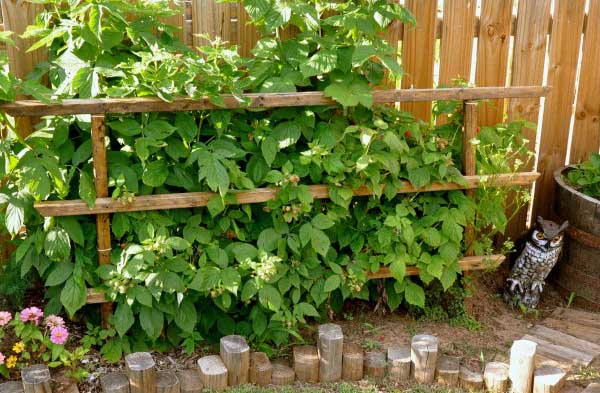
Blackberry breeding methods
Blackberry propagation methods depend on its type and variety:
- for upright varieties of shrubs suitable for reproduction by root suckers and cuttings, dividing the bushes, but propagation with apical and horizontal layers is hardly possible, although theoretically it is possible.
- for creeping Shrub varieties are suitable for reproduction by the tops of replacement shoots (apical cuttings), horizontal cuttings, root suckers and cuttings, green cuttings.
Important! For thornless varieties, propagation by root suckers and cuttings is not suitable, while for prickly varieties, for example, it is even preferable.
There are the following ways to reproduce blackberries:
- seeds;
- replacement shoots tops (apical layers);
- horizontal layering;
- root suckers;
- root cuttings;
- cuttings (green and lignified stem cuttings, including a dormant bud in water);
- dividing the bush.
Roughly speaking, there are only 5 methods - by seeds (the most ineffective), layering (apical and horizontal), roots (root suckers and cuttings), stem cuttings (rather ineffective) and dividing the bush.
Thus, each gardener not only chooses for himself the optimal time for planting, but also the most favorite method of obtaining a new planting material, depending on the type of shrub.
Next, we will consider in more detail each of the named ways of breeding blackberries.
Seeds
Perhaps this is the easiest way to propagate any crop, but in the case of blackberries and many other berry and fruit crops, it is the most ineffective and impractical. Therefore, it is much more correct to use the methods of vegetative reproduction, which will be discussed below.
Note! The fact is that when blackberries are propagated by seeds maternal (parental) characteristics are not preservedThat is, by taking seeds of a certain variety, in the end you will get something completely new and, unfortunately, the changes will not be for the better.
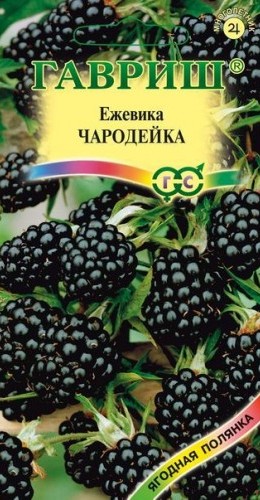
In general, the process of planting blackberries for seedlings is quite standard. The main thing to remember is that blackberry seeds first need stratify (within 1.5-2 months), and immediately before sowing subject scarification.
Important! The author of this video did not carry out the above-mentioned pre-landing events.
Video: planting blackberry seeds
Replacement shoots tops (apical layers)
The essence of this method of reproduction of blackberries is that many varieties are capable of rooting well if you bury (dig) the tops of their replacement shoots into the ground.
Note! Blackberry propagation by the tops of replacement shoots ideal for creeping varieties (e.g. Loganberry, Texas, Boysen), slightly less for intermediate, which combine the signs of erect and creeping varieties (for example, Smutstem, Thornfrey, Black Setin). And here upright varieties (like Darrow, Agavam) tops take root enough reluctantly, since the top of an upright shoot cannot be easily bend down and buried in the ground ...
Optimal time for propagation of blackberries with the tops of replacement shoots is late summer (august) — beginning of autumn (first half of September). In the southern regions, this can be done earlier, for example, at the beginning of summer, then you will receive a new seedling this year..
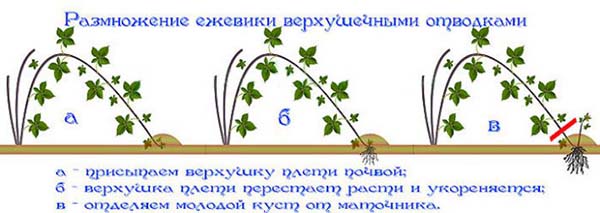
Step-by-step instructions for reproducing blackberries with the tops of replacement shoots:
- First, you need to pinch off the growth point of the replacement shoot selected for propagation.
Important! If you ignore this mandatory recommendation, then the replacement shoot will simply come out of the ground over time and continue to grow. Naturally, in the end, no roots are formed in the place of the trench, unless in exceptional cases and, of course, a developed root system will not be laid.
- Pick off all the leaves.
- Next, you need to bend the pinched shoot and bury it in the ground (about 5-10 cm).
- Or, you can dig the top into a separate pot of soil (it's even more convenient!).
Note! In no case should you separate the buried replacement shoot from the bush. It is thanks to the nutrition received from the mother bush (mother plant) that the tip of the shoot will be able to grow roots, and then lay a bud of the replacement shoot in the ground.
- Depending on the timing of rooting, already this year (closer to the beginning of autumn - August-September), a new shoot may appear, although most often this happens the next year (in spring).
By the way! It is considered optimal when the shoot bud hibernates in the ground, i.e. the shoot appears only next spring. The fact is that the shoot that appears in summer or autumn may not have time to ripen and because of this it will simply freeze out in winter.
- That's it, in the fall of this year or next spring, you just have to separate the layers - new seedlings from the mother (more precisely, the mother) bush and transplant them to a new permanent place or to a school for further growing with subsequent planting in the fall.
Advice! Be sure to cover one-year-old seedlings for the winter shortly before the first frost.
Video: the simplest way to reproduce blackberry propagation by the tops of the shoots
Horizontal layering
By the way! In general, the principle of reproduction of blackberries by layering and tops of replacement shoots is similar.
It is best to propagate creeping blackberries in this way, because shoots will have to be bent to the ground, as in the case of reproduction by the tip of replacement shoots.
Optimal time for propagation of blackberries by layering - late summer - early autumn (August-September). In the southern regions, it can be done earlier - in the early to mid-summer.
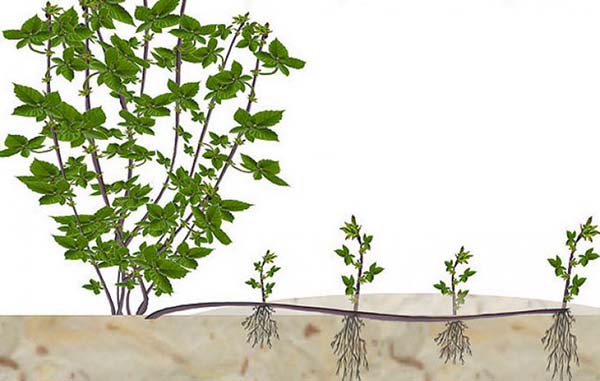
This method is great if you have a sufficient amount of blackberries, since you need to drop shoots into the ground that could bear fruit next summer.
So, to propagate a blackberry by layering, you need:
- Dig a small groove 15-20 cm deep (to concentrate moisture).
- Bend the long annual shoot to the ground in this groove.
- Fasten it on both sides (at the base and in the apical part) with a bracket or hook, or press down the already dug shoot with a brick.
By the way! The top of the shoot must first be left above the soil surface, and then cut off to stop further shoot growth.
- Now dig on top of the ground by 20 cm (slightly less than the bayonet of the shovel).
- Next, thoroughly mulch something (so that the earth does not dry out) and water thoroughly.
- Depending on the timing of the rooting of the cuttings, new shoots may appear this year, but it is better if this happens next spring.
- Everything, strong and well-rooted seedlings can now be dug up, separated from the mother plant and transplanted to a permanent place.
Root offspring
Interesting! It's no joke, but it's not so easy to get rid of blackberries, because they reproduce very well by root suckers. What's the point? When transplanting or uprooting bushes in the ground, in any case, parts of the roots remain, and it is from them that offspring appear.
Thus, for the classic propagation of blackberries by root suckers in the open field, you need:
- Dig up and cut pieces of roots 8-10 cm long, at least 3-4 mm in diameter.
A few tips for harvesting and storing root suckers (cuttings):
- As for the timing, then the very harvesting of root cuttings (offspring) is recommended in late autumn (in October-November), when the bushes are already sleeping.
- The offspring (cuttings) should be taken no closer than 60 cm from the center of the bush (so as not to cause serious damage to the mother plant).
- You can store offspring in a cellar in damp sand or another similar place (like grape cuttings).
- In the spring, bury the root segments horizontally (not vertically!) Into the ground to a depth of 4-5 cm.
- Water and maintain moderate humidity thereafter.
- After a couple of weeks, new offspring will appear.
Note! Unfortunately, as a rule (but there are exceptions, for example, the Thornfrey variety), when propagating thornless varieties in this way, thorny varieties eventually grow, therefore, blackberry propagation by root suckers is most often used to propagate thorny varieties.
In a greenhouse (greenhouse), blackberries can be propagated by root suckers in a slightly different way (using shorter cuttings):
- Harvest cuttings (more precisely, root segments) 2.5-3 cm long.
Important! The root section is buried in strict observance of the polarity. The top and bottom of the root sucker should be positioned in the same way as they grew on the root of the plant (the bottom of the root is at the bottom, the top is on top).
Advice! In order not to accidentally confuse the polarity when planting, when cutting a long root into short segments, the upper part of each offspring is cut perpendicular to the root axis, the lower one - at an acute angle.
- Next, bury them in the ground vertically (not horizontally!) To a depth of 5.5-6 cm, i.e. from the top of the cutting to the surface of the earth should be 3 cm.
- In a few weeks, new offspring will appear.
Root cuttings
By the way! In general, the principle of propagation of blackberries by root cuttings and offspring is similar.
Again it is used for propagation of creeping varietieswhich give few root suckers. If upright varieties also do not give offspring, then their You can also try propagate by root cuttings.
Let's repeat! And here it is impossible to propagate thornless varieties of blackberries by root cuttings, since they eventually grow thorny plants (with thorns).
So, to propagate blackberries by root cuttings, you should:
- In late autumn or early spring, carefully dig out the entire root system of the uterine fruiting bush.
- Cut it into pieces or cut off the roots at least 60 cm from the bush.
Advice! It is optimal for reproduction to use young 1-3-year-old roots, which have an average thickness of about 0.3-1.3 cm and a length of 5-10 cm.
- Root cuttings are planted either directly to a permanent place, or left for storage and growing at home.
In winter, cuttings can be stored in the basement, in damp sand, and in spring they can be planted in open ground. It is even better to put them in a container first, sprinkle them with sawdust for germination, and when they hatch, transplant them into the garden.
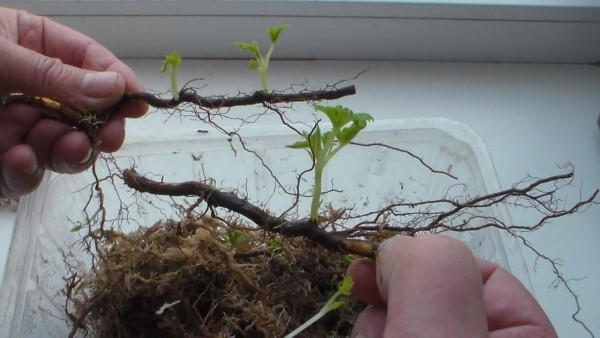
- When planting, cuttings are placed in grooves in rows to a depth of 10-12 cm, with a distance between them in a row of 20 cm, between rows - 70-80 cm. Then the grooves with cuttings are covered with loose earth and regularly watered until rooting. Also, several weeding and loosening of the soil is carried out during the summer.
- By the fall, good planting material with 1-2 shoots and developed roots grows from root cuttings.
Video: blackberry propagation by root cuttings
Video: sprouting root cuttings of blackberries
By cuttings: green or woody stem cuttings
Blackberries can be propagated by green and lignified stem cuttings.
Green cuttings
Green blackberry cuttings are usually cut in summer (about in June-July), in other words, green cuttings convenient to combine with summer pruning and normalization of shoots.
By the way! This method is usually used for reproduction creeping varieties blackberries.
Advice! It is very good to propagate varieties such as Thornfree, Thornless Logan, Black Satin with green cuttings. But Dirksen Thornless takes root weakly, Smutstem takes root very badly.
Blackberry propagation by green cuttings is as follows:
- In the middle of summer (in July), green cuttings with several internodes are cut from the shoots (usually from root suckers).
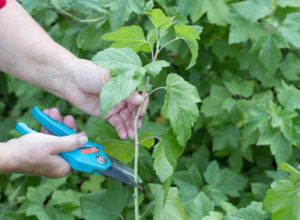
Important! The upper part of the shoot is suitable for rooting, but it is the top (the very last 2 buds) that needs to be cut off.
- As a result, the cutting should have only 2 pairs of leaves (2 internodes), and the lower leaves of each cutting must be removed completely, leaving the foam, and the upper ones must be shortened by 1/2 (or just leave no more than 2 leaves).
- Next, the cuttings should be planted in small containers (pots, cups) filled with a soil mixture consisting of equal parts of peat and any baking powder (sand, perlite, vermiculite).
Advice! For better rooting, cuttings can be dipped in a root stimulator (Kornevin or Heteroauxin).
- Then the containers with cuttings should be placed in a greenhouse or film greenhouse, where the humidity is very high - 95-100%, i.e. the soil inside must be constantly kept moist so that evaporation takes place (more precisely, there must be a kind of "artificial fog" in the greenhouse).
Of course, you can root without fog by covering the container with the handle with a film or bottle, thereby making a mini-greenhouse.
- A month later (3-4 weeks), when the cuttings begin to actively grow and roots form and new leaves appear, they can be planted in a permanent place in the garden.
Note! Unfortunately, without high humidity and fog, most green cuttings will not take root. So, according to statistics, only about 10% of them survive. In other words, the method is rather ineffective.
Video: grafting blackberries for rooting in the fog
Video: how cuttings take root in a greenhouse with fog
Lignified cuttings
If you did not have time to cut the greenery cuttings in summer, then this can be done closer to autumn.
Important! Not all varieties of blackberries reproduce well with lignified cuttings, many simply die.
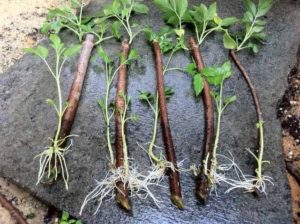
To propagate blackberries with lignified cuttings, you must:
- In autumn, from annual, already lignified shoots, cut cuttings 20-30 cm in length.
- Dig them in the garden until spring to a depth of 20 cm (or save in any other way).
- In the spring, dig up, update the cuts on both sides (the total length of the cutting should be 15-20 cm), spread out in rows, retreating 5-10 cm from one another, and cover with earth again.
- Water, weed and wait for shoots. For quick germination, place arcs and cover with foil.
- When bushes with 2-3 true leaves grow on the garden bed, carefully remove the cuttings from the ground and plant them in a permanent place.
Video: reproduction of blackberries by stem cuttings
Reproduction in water by a sleeping bud
And you can also propagate blackberries with lignified cuttings like this:
- In early spring (February-March), put the cuttings on the windowsill in the water with the top down (note: the roots appear precisely on the apical bud, for this they turn the cutting upside down).
Water should be poured so that it covers only one lower kidney.
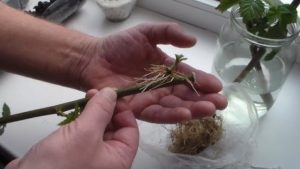
- Be sure to add water periodically as it evaporates.
- Wait for the roots to appear and transplant into a separate pot with loose soil. Or immediately plant it in the garden in a permanent place when the soil has completely thawed.
By dividing the bush
This method of propagation of blackberries is used when the shrub cannot be propagated in any other way, for example, it does not have young shoots or does not give offspring, and the tops do not bend down (this is an upright variety).
As for the timing, the procedure for breeding blackberries by dividing the bush can be carried out in the spring, after the last snow melts. Or in the fall, 3-4 weeks before frost, so that the bushes have time to take root. The advantage of blackberry reproduction by dividing the bush in the fall is preparation for winter and natural stratification of the bush, after which a particularly strong immunity is developed in the seedling.
- Naturally, you first need to dig out the bushes themselves.
- Next, divide the bushes into several separate parts so that each has several healthy young shoots (2-3) with well-developed roots, in which at least one underground kidney was present. And here old rhizomes are not used for reproduction.
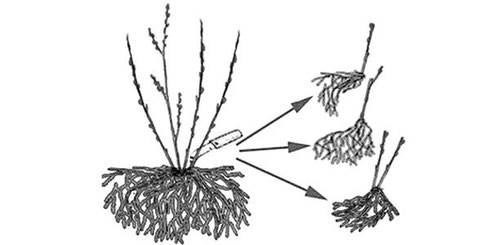
- Next, plant the seedlings in the prepared holes in the standard way.
As a rule, by propagation by dividing one good adult blackberry bush, you can get up to 5-6 new.
Thus, now you know all the ways to propagate blackberries, including layering, offspring and cuttings. Try, experiment, and you will definitely succeed! Just don't stop if it didn't work out the first time, test at least 2-4 methods. Good luck!
Interesting! Many people reasonably believe that blackberries are a berry weed! The twig bent slightly to the ground and immediately gives roots. Therefore, first of all, try to propagate the bushes with the tops of the shoots or drop in whole shoots.

